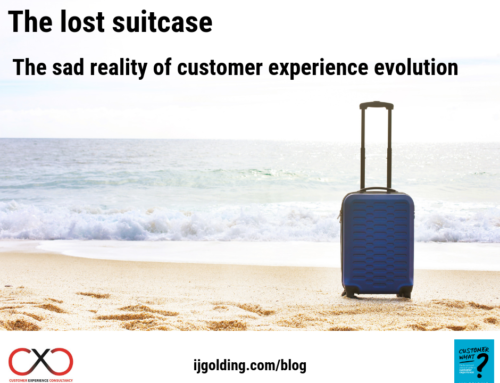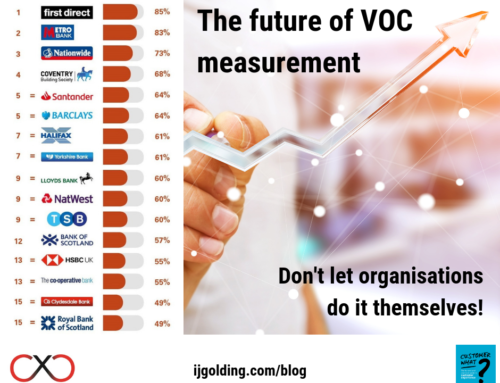I have often wondered about the pros and cons of incentivising customer feedback. I am not sure what kind of person this makes me – hopefully one that is forever focussed on all of the things around us that can and will contribute to customer experiences being made better!
Capturing customer feedback is not easy. In fact, some organisations find it very difficult to get customers to tell them what they really think. Some would argue that this is because customers ‘do not care enough’. Some would say that particular organisations do not have a large enough customer base, and as such, opportunity to capture feedback is limited. Customers might point out that they never see what happens with feedback that is provided, so why bother!
At the beginning of this year, I wrote a blog post about the retailer Boden. They had used Facebook as a means of capturing feedback about their brand. It was a very economical, quick and effective way of doing it. However, 8 months later, and we as Boden customers have no idea what they did with the feedback – this is despite me contacting Boden directly to ask (they did not respond). You can read the full blog post here – https://ijgolding.com/2013/01/10/hats-off-to-you-boden-but-it-depends-what-you-do-with-the-insight/
Boden’s actions, or inaction in this case, will ensure that a proportion of customers who gave feedback in January may not do so again. This will only make it harder for them to continuously capture feedback going forward. It is this word ‘continuously’ that is vital here. Capturing feedback from customers MUST be a regular, continuous process. You cannot capture feedback today and never ask again. Unfortunately, customers are tricky things – what they want today, may be completely different in six months time. It is critical to CONTINUOUSLY understand customers needs over time.
If you do not capture feedback effectively, it will become more and more difficult to keep the process continuous. This interesting blog post from Econsultancy, states 20 ways to capture feedback http://econsultancy.com/uk/blog/8109-20-ways-to-get-reviews-from-customers. The methods all point towards ways that can be used to encourage customers to feedback, thus helping you to maintain a continuous flow. Method number 9 is ‘incentivise me’ – it is this method I want to focus on.
One way of trying to ‘keep’ or ‘get’ customers ‘engaged’ with providing feedback is to incentivise them to give it. Many organisations do this. I recently took Jack, my 5-year-old son for a hot chocolate in Café Nero. On every table was a card. ‘Tell us how we did and you might just win free coffee for a month or an iPad’. Whilst Jack was tucking in, I pondered this. Will it really work? It certainly did not with me – I had no intention of being ‘coerced’ into giving them feedback when I did not really have any feedback to give. That was my instant reaction – I do not actually have anything to say, so why would I, other than trying to win something?
I suppose what I am trying to say is that I believe that incentivising feedback can (and I stress the word can) have the effect of artificially enhancing customer feedback. It is very likely that customers will give you feedback, just to be entered into a prize draw – not necessarily because they have anything to say. It is likely that feedback will be either positive or neutral than negative.
Capturing customer feedback serves a very important purpose. It acts as the external mirror to the organisation. It provides you with the reality of what customers think of your products, service and end to end customer journey. It enables you to understand WHERE in the customer journey you are failing to meet customer expectation. As a result, it provides you with the priorities for improvement (from a customer perspective). If you do not structure your customer feedback programme correctly, or use methods that have the potential to skew the results, you run the risk of failing to identify the correct priorities for improvement.
Last week, we had a family trip to Pizza Express. The service was actually first class, and I was very impressed. At the end of the meal, I was handed a card (which you can see below). I have not seen this in Pizza Express before. Like Café Nero, Pizza Express have decided to start incentivising customer feedback – in this case, you get a free portion of garlic bread or dough balls, just for giving the feedback! They will also enter you in to a free prize draw. I actually think the garlic bread and dough balls ‘giveaway’ is a smart move – a low value item that may not just get you feedback but that could also get you to return. However, I think it is unnecessary to add-on the £500 gift card as well.
So how else could brands like Pizza Express capture feedback, without having to use incentives? The most important thing for any business is to get real feedback that allows you to take the appropriate action. Providing customers with simple, quick and instant methods to encourage customers to say what they think when they are thinking it is important. Maybe giving customers a tablet computer with a short survey to complete at the same time as receiving your bill could be a neat way for Pizza Express to do it. They are likely to get very high participation, create a little bit of theatre, and keep everyone busy whilst the bill is being paid. There would be no need for incentivising anyone. Additionally, they would be getting feedback at the point the experience is completely fresh in the mind – this is when it is most accurate and real.
So the next time you are asked to complete a survey to receive an incentive, have a think about exactly why you are taking the action you are. Are you doing it to get a prize, or because you actually have valuable feedback to give? Are you not doing it because you do not want to be ‘bribed’? Incentivising feedback can work, but be very careful how you do it, or the feedback you get will not give you the real representation of your customer journey that you need.
As always, your thoughts on comments on this blog post are very welcome.








Interesting article. I don’t think incentivising is a positive way to garner customer feedback. When companies incentivize, the feedback is not always authentic and reliable. Incentivizing is oftentimes seen as bribing. Imagine one company was to offer (as an extreme) a Ferrari as an incentive for giving a review while another company was only able to offer a $5 dollar off coupon–who is going to get the better review there? Reviews get thwarted when incentives are involved. Oftentimes, reviews are even fake now if you refer to all the news articles out there right now the U.S.Gov’ts (and even abroad are dealing with) and that is why we must have REAL, authenticated customer feedback based on an ACTUAL transaction. That’s why it is important for companies who want this feedback to work with independent third-party providers, like eKomi, for example. Working with someone like that ensures that you gain REAL reviews and feedback while also doubly benefitting by getting your gold stars in Google!
Thank you so much for taking the time to comment on this subject – it is very much appreciated. I am glad that we are in agreement!!